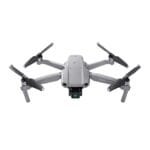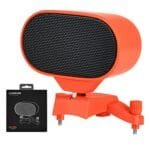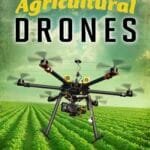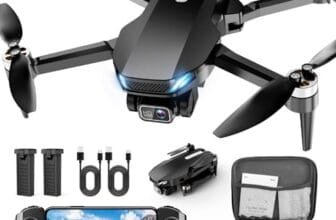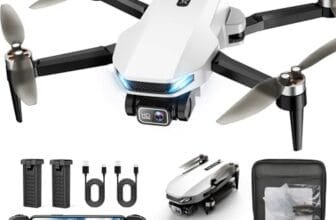
Drones enhance coastal monitoring with precision and efficiency. They offer valuable insights into environmental changes and marine life.
Coastal monitoring is crucial for understanding and protecting fragile marine ecosystems. Drones have become essential tools in this field. They provide accurate data, helping scientists and researchers track environmental changes. These flying devices can access hard-to-reach areas, capturing detailed images and information.
They help monitor erosion, pollution, and wildlife patterns. Two notable resources for drone enthusiasts are “Drones For Environmental Assessment: Vol. 2” and “UAV or Drones for Remote Sensing Applications in GPS/GNSS Enabled and GPS/GNSS Denied Environments. ” These resources offer insights into the latest technologies and applications. Choosing the right drone can enhance data collection and environmental understanding. Let’s explore the best drones for coastal monitoring.
Drones For Environmental Assessment: Vol. 2

Drones For Environmental Assessment: Vol. 2 is an excellent resource for environmental scientists, researchers, and conservationists who are keen on leveraging drone technology for assessing and managing environmental concerns. This publication is particularly beneficial for professionals and students who are looking to explore the practical applications of drones in the environmental sector.
Pros:
- Comprehensive coverage of drone applications in environmental assessment.
- Lightweight and easy to carry.
- Published by Our Knowledge Publishing, ensuring quality content.
- Concise with only 60 pages, making it a quick read.
Cons:
- Limited to only 60 pages, which might not cover every aspect.
- Being a niche topic, it may not appeal to a general audience.
The features of Drones For Environmental Assessment: Vol. 2 are tailored to provide a clear understanding of how drones can be utilized for environmental monitoring and data collection. The manufacturer, Our Knowledge Publishing, has ensured that the content is both informative and accessible, catering to both professionals and enthusiasts. With a compact design and easy-to-digest content, the book serves as a valuable tool for those looking to incorporate drones into their environmental assessment toolkit.
The benefits of this publication are manifold; it empowers users with knowledge on how to effectively deploy drones in diverse ecological settings, enhancing their ability to conduct thorough assessments with precision. Moreover, the lightweight nature of the book makes it convenient for fieldwork, allowing users to have a handy reference while on-site. The publication date of 2022 ensures that the content is up-to-date with the latest technological advancements and methodologies in the field of environmental assessment using drones.
To buy this product, click here.
Uav Or Drones For Remote Sensing Applications

The ideal customer for the UAV or Drones for Remote Sensing Applications is someone involved in environmental monitoring, precision agriculture, or geospatial research. These individuals should have a keen interest in utilizing advanced technology for data collection and analysis in both GPS/GNSS enabled and denied environments. If you’re looking to enhance your remote sensing capabilities with reliable and versatile UAV technology, this item is tailored for your needs.
Pros:
- Versatile applications in both GPS/GNSS enabled and denied environments.
- High-quality manufacturing by Mdpi AG, ensuring durability and reliability.
- Comprehensive content with 400 pages of detailed information.
- Latest insights with a publication date of 2021, keeping you updated with current trends.
Cons:
- Weight might be a concern for some, as it is over 2 pounds.
- The dimensions might not be suitable for all storage or transport requirements.
The UAV or Drones feature cutting-edge technology that supports remote sensing applications effectively in challenging environments. With their ability to operate in GPS/GNSS denied areas, they open up possibilities for data collection in regions where traditional methods fall short. This unique capability greatly benefits users who need to conduct research or surveys in remote or inaccessible locations, providing them with valuable insights that were previously hard to obtain.
Users will appreciate the quality manufacturing by Mdpi AG, which assures durability and robust performance in various conditions. The item, spanning 400 pages, offers extensive information and guidance on maximizing the use of UAV technology for remote sensing. Its recent publication date ensures that users have access to the most up-to-date knowledge and practical advice, making it an indispensable tool for professionals in the field.
To buy this product, click here.
Frequently Asked Questions
What Are The Best Drones For Coastal Monitoring?
The best drones for coastal monitoring offer advanced sensors and stability. They should withstand harsh weather and provide high-resolution imaging. Popular choices include drones with GPS/GNSS capabilities for precise navigation. They help in environmental assessment and data collection in both GPS-enabled and GPS-denied environments.
How Do Drones Assist In Environmental Assessment?
Drones provide aerial views for comprehensive environmental assessments. They capture detailed images and data over large areas. This helps in monitoring coastal erosion, wildlife habitats, and pollution. Drones can access remote areas, making them invaluable for environmental scientists and researchers.
Can Drones Operate In Gps-denied Environments?
Yes, some drones are designed for GPS-denied environments. They use alternative navigation systems for precise operation. These drones are equipped with advanced sensors and algorithms. This allows them to function effectively even without GPS signals, essential for challenging coastal monitoring tasks.
Why Is Remote Sensing Important For Coastal Monitoring?
Remote sensing allows for efficient data collection over large coastal areas. It provides real-time insights into environmental changes and threats. This technology helps in tracking erosion, storm impact, and marine life. It is crucial for sustainable coastal management and conservation efforts.
What Features Should Drones For Coastal Monitoring Have?
Drones for coastal monitoring should have robust weather resistance and long battery life. High-resolution cameras and sensors are essential for detailed imaging. GPS/GNSS capabilities enhance navigation accuracy. They should also be portable and easy to deploy for efficient field operations.
Conclusion
Coastal monitoring benefits greatly from the use of drones. They provide essential insights into environmental changes. Drones like those in “drones for environmental assessment: vol. 2” are valuable tools. They help in tracking coastal erosion and wildlife habitats. Uavs in gps/gnss enabled environments enhance data accuracy.
They provide reliable information for decision-making. In gps/gnss denied environments, drones still perform well. They gather data crucial for understanding coastal dynamics. These drones offer cost-effective solutions. They reduce the need for expensive manned surveys. Easy to deploy, they save time and resources.
Their versatility makes them suitable for various coastal monitoring tasks. By choosing the right drone, you can improve environmental assessments. This can lead to better coastal conservation strategies. With advancements in drone technology, monitoring will continue to evolve. Investing in drones for coastal monitoring is wise.
It ensures the protection of precious coastal ecosystems.

